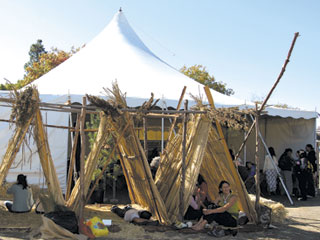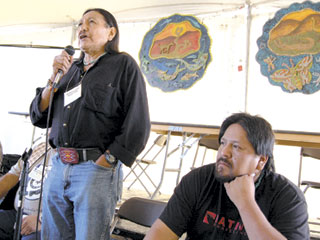2008 Bioneers Conference hosts first indigenous tent
By Shadi Rahimi, Today correspondent
SAN RAFAEL, Calif. – After
19 years of hosting a “green” festival, the 2008 Bioneers Conference
hosted its first-ever “indigenous tent” this year.
Bioneers founders Kenny Ausubel and Nina Simons referred to indigenous peoples as “the world’s original bioneers” in the program and said they were “deeply honored” to collaborate with the Indigenous Environmental Network and Cultural Conservancy to host the tent.
“We’ve got to fight for a new environmental paradigm,” said IEN Director Tom Goldtooth during a panel on climate change. “The machine continues. They’re ‘green-washing’ ourselves.”
Organic foods, herbal remedies and natural fibers were the norm Oct. 17 – 19, and the tent was the one space where Native people could be found networking and speaking to the mostly white Bioneers crowd about environmental struggles in Indian country.
“We’re here to invite you to join us,” said Radley Davis, Pit River, during a panel on sacred sites. “We’re all facing the same issues. We need to address them as one.”
Conference attendees, took in the shade beneath three traditional tule huts at the tent and speakers shared California basket making, tule hut and bird dance and song demonstrations, and insight on environmental issues.
During a youth panel, five speakers shared thoughts about cultural conservation “As a Tool for Social Justice,” including the preservation of languages in Canada, northern California and South Dakota, and the legacy of boarding schools on their families and their knowledge.
“The steps we are taking now are not only about contemporary times, but solutions to the trauma in the past,” said panel facilitator Dallas Goldtooth.
Attendees filled the tent during a panel on sacred sites. Manny Pino, Acoma Pueblo, spoke about how Native people must fight in the courts for the same religious rights granted to all others because “indigenous peoples are always an afterthought.”
Pino spoke about the pain of being forced to share spiritual practices in courtrooms “just to defend our case.” But that’s necessary when arguing cases like the San Francisco Peaks in Flagstaff, Ariz., a sacred mountain where a ski resort uses recycled wastewater to create fake snow, he said.
In response to protests, the Bureau of Land Management has been asking how to best oversee a sacred site, said Navajo Kelvin Long of the nonprofit E.C.H.O.E.S.
“We tell them you can’t ‘manage’ a sacred site. We can’t wait until science catches up to us; you have to listen to the people of this land.”
Pino spoke about how Native struggles to protect sacred sites become interpreted as “obstacles to economic progress,” citing the Zuni in western New Mexico and their battle to preserve the salt water from SRP’s 18,000-acre coal mine that for 50 years sucked 85 gallons of water a minute from the river. After a “long, tedious effort” by Zuni spiritual leaders, the river was spared in 2003 upon being placed in national trust, he said. But SRP has moved on to waterways in Wyoming.
Matthew Leivas Sr., Chemehuevi from southern California, spoke of the desecration of sacred springs and sites in his region. Shrapnel from World War II still litter the desert, and now off-road vehicles raze the landscape. Tailings from uranium mining in the Colorado Plateau in the late 19th century continue to contaminate Lake Mead, the Colorado River and other waterways, he said.
With gaming money from its casino, his tribe has begun buying back some of the land it lost upon contact with European settlers. And through a project called the Salt Song Trail, they and 12 other Southern Paiute bands from California, Arizona and Nevada are reviving traditional songs and honoring those who never came home from the Sherman Indian School, a boarding school in Riverside.
Davis spoke about how the 9th Circuit court had ruled in favor of protecting the Medicine Lake highlands from a proposed geothermal plant. But “we knew we could not celebrate too soon,” he said. This past summer, the BLM and Calpine Corp. began pushing again for drilling.
“We do not consider geothermal ‘green energy’ because the impact on our area would be irreparable. It would be damaged forever.”
The push against harmful development and the revival of lands was a major theme among speakers, and Native audience members brought up new concerns.
An Oneida woman almost cried as she spoke about biofuels: “To have our corn burned for the purpose of gas in cars goes against the belief of my people. Corn is sacred and corn is food.”
At a panel on “The Sacredness of Water,” Winnemem Wintu Chief Caleen Sisk-Franco declared that now “coal miners have turned to blue gold.”
She puffed smoke from a pipe onto a California water basket woven by Kathy Wallace, which was passed to each panelist to “speak over the water.” Tia Oros Peters, a Zuni who works for the Seventh Generation Fund, spoke about how villages once thrived along the Zuni River.
Today, the region is joked as being only “dust and dogs,” a result of dams built by Mormon missionaries “hungry for souls,” she said. The river was strangled. Her husband’s people, the Yurok, now face similar threats from seven dams on the Klamath River.
Bioneers founders Kenny Ausubel and Nina Simons referred to indigenous peoples as “the world’s original bioneers” in the program and said they were “deeply honored” to collaborate with the Indigenous Environmental Network and Cultural Conservancy to host the tent.
“We’ve got to fight for a new environmental paradigm,” said IEN Director Tom Goldtooth during a panel on climate change. “The machine continues. They’re ‘green-washing’ ourselves.”
Organic foods, herbal remedies and natural fibers were the norm Oct. 17 – 19, and the tent was the one space where Native people could be found networking and speaking to the mostly white Bioneers crowd about environmental struggles in Indian country.
“We’re here to invite you to join us,” said Radley Davis, Pit River, during a panel on sacred sites. “We’re all facing the same issues. We need to address them as one.”
|
Photo courtesy Shadi Rahimi
Manny Pino spoke about the pain of being forced to share spiritual
practices in courtrooms “just to defend our case,” at the 2008
Bioneers Conference in San Rafael, Calif. |
Conference attendees, took in the shade beneath three traditional tule huts at the tent and speakers shared California basket making, tule hut and bird dance and song demonstrations, and insight on environmental issues.
During a youth panel, five speakers shared thoughts about cultural conservation “As a Tool for Social Justice,” including the preservation of languages in Canada, northern California and South Dakota, and the legacy of boarding schools on their families and their knowledge.
“The steps we are taking now are not only about contemporary times, but solutions to the trauma in the past,” said panel facilitator Dallas Goldtooth.
Attendees filled the tent during a panel on sacred sites. Manny Pino, Acoma Pueblo, spoke about how Native people must fight in the courts for the same religious rights granted to all others because “indigenous peoples are always an afterthought.”
Pino spoke about the pain of being forced to share spiritual practices in courtrooms “just to defend our case.” But that’s necessary when arguing cases like the San Francisco Peaks in Flagstaff, Ariz., a sacred mountain where a ski resort uses recycled wastewater to create fake snow, he said.
|
Photo courtesy Shadi Rahimi
Winnemem Wintu Chief Caleen Sisk-Franco declared that now “coal miners
have turned to blue gold” at a panel discussion on “The Sacredness of
Water” at the 2008 Bioneers Conference. |
In response to protests, the Bureau of Land Management has been asking how to best oversee a sacred site, said Navajo Kelvin Long of the nonprofit E.C.H.O.E.S.
“We tell them you can’t ‘manage’ a sacred site. We can’t wait until science catches up to us; you have to listen to the people of this land.”
Pino spoke about how Native struggles to protect sacred sites become interpreted as “obstacles to economic progress,” citing the Zuni in western New Mexico and their battle to preserve the salt water from SRP’s 18,000-acre coal mine that for 50 years sucked 85 gallons of water a minute from the river. After a “long, tedious effort” by Zuni spiritual leaders, the river was spared in 2003 upon being placed in national trust, he said. But SRP has moved on to waterways in Wyoming.
Matthew Leivas Sr., Chemehuevi from southern California, spoke of the desecration of sacred springs and sites in his region. Shrapnel from World War II still litter the desert, and now off-road vehicles raze the landscape. Tailings from uranium mining in the Colorado Plateau in the late 19th century continue to contaminate Lake Mead, the Colorado River and other waterways, he said.
With gaming money from its casino, his tribe has begun buying back some of the land it lost upon contact with European settlers. And through a project called the Salt Song Trail, they and 12 other Southern Paiute bands from California, Arizona and Nevada are reviving traditional songs and honoring those who never came home from the Sherman Indian School, a boarding school in Riverside.
Davis spoke about how the 9th Circuit court had ruled in favor of protecting the Medicine Lake highlands from a proposed geothermal plant. But “we knew we could not celebrate too soon,” he said. This past summer, the BLM and Calpine Corp. began pushing again for drilling.
“We do not consider geothermal ‘green energy’ because the impact on our area would be irreparable. It would be damaged forever.”
The push against harmful development and the revival of lands was a major theme among speakers, and Native audience members brought up new concerns.
An Oneida woman almost cried as she spoke about biofuels: “To have our corn burned for the purpose of gas in cars goes against the belief of my people. Corn is sacred and corn is food.”
At a panel on “The Sacredness of Water,” Winnemem Wintu Chief Caleen Sisk-Franco declared that now “coal miners have turned to blue gold.”
She puffed smoke from a pipe onto a California water basket woven by Kathy Wallace, which was passed to each panelist to “speak over the water.” Tia Oros Peters, a Zuni who works for the Seventh Generation Fund, spoke about how villages once thrived along the Zuni River.
Today, the region is joked as being only “dust and dogs,” a result of dams built by Mormon missionaries “hungry for souls,” she said. The river was strangled. Her husband’s people, the Yurok, now face similar threats from seven dams on the Klamath River.
© 1998 - 2008 Indian Country Today. All Rights Reserved To subscribe or visit go to: http://www.indiancountry.com


